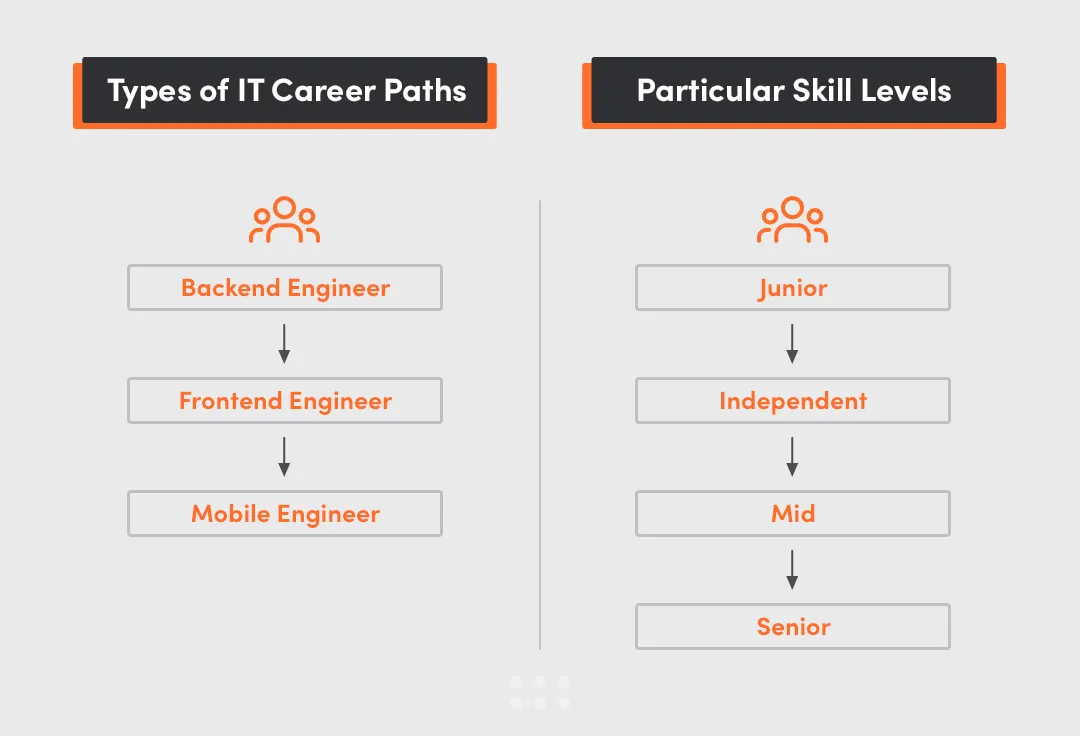Every CTO of a software company wants their business to thrive. While there are many ways to accelerate growth that require a large investment of time or resources, creating an IT-specific career path for software development teams can be a cost-effective way to boost motivation and job satisfaction.
Providing your employees with career progression frameworks can change how they view your company and, in turn, bring you closer to achieving your business goals.
But how to set up an effective career framework for software teams? This article will give you the basic knowledge needed to undertake this important task. Here you can check out our proprietary career path software (DevPath), which will save you hundreds of hours in designing your own approach.
What will you learn from this article:
- What is a career path?
- Why are career pathing frameworks important in IT?
- What are the types of IT career paths and particular skill levels
- How should companies approach developing their career frameworks?
- What steps does a business need to take to create a successful career progression framework?
- How can companies with fewer resources build their career progression frameworks?
-
Implementing an effective career progression framework can lead to higher employee engagement, satisfaction, and retention rates.
-
Employers can see and track their own growth, which provides a sense of motivation and accomplishment and fuels a culture of continuous advancement.
-
Clear requirements and expectations for specific job levels make it easier for team members to align their goals with their career pathways.
-
Having a set career progression framework may attract more top talent looking for growth opportunities.
-
It is important to describe every position and be transparent about the criteria for advancement if employees are to trust the employer.
-
A career progression framework can help a business plan its succession in advance, ensuring that there are qualified individuals prepared to take on higher roles when needed.
-
Businesses can look into career pathing tools to shorten the process of creating one.
Why Is a Career Path so Important and Why Should You Have a Career Pathing Framework?

An IT career path is a valuable tool for setting clear goals and objectives, as well as providing a direction for professional growth and employee development. It defines specific levels that can be reached one after another when growing and getting promoted. So why should your company have one?
Higher Employee Engagement
It is a common result of implementing an effective career progression framework in your software development house.
When your developers see that their commitment is reflected in their growth according to their career path, they may feel more motivated to reach more advanced levels sooner.
It also provides them with satisfaction and a sense of accomplishment, leading to increased employee retention rates.
Trust and Loyalty
When provided with a clear idea of what lies ahead, software developers will be aware of the steps they need to take to advance in their career pathway and of the rewards that come with it. This can foster more trust and loyalty towards the organization, as being informed in advance about what is required of them lets employees feel more stable and secure in their positions.
Easier Personal Development Planning
For software development houses, defined career frameworks can provide a concept of what may happen in the future. This allows planning personal development more efficiently, without chaotic guesswork and uncertainty.
Increased Chance of Attracting Top Talent
Highly skilled software developers usually look for transparent companies that are open about their expectations and opportunities to climb the career ladder.
SDHs that clearly define career progression can attract and retain top candidates motivated by the potential to advance.
They will likely be more interested in joining your company if they are aware of the prospect of growth there.
Defining Types of IT Career Paths and Particular Skill Levels
Depending on your organization's work, there may even be other names for very specific, specialized levels, like React Frontend Developer or Cloud DevOps Engineer. You can even define individual contributor names to their career path.

Despite numerous career options for those interested in web development, the three main ones that need to be clearly emphasized are backend, frontend, and mobile development.
Types of IT Career Paths
Backend Engineer
Backend Engineers develop server-side code, manage databases, and create APIs for software applications. They ensure performance, security, scalability, and business logic.
Frontend Engineer
Frontend Engineers specialize in creating the user interfaces of web applications. They focus on designing and developing the visual elements and user interactions. Frontend Engineers can diverge into two distinct tracks: web frontend and mobile app development.
Mobile Engineer
Mobile Engineers are experts in developing software applications for mobile devices such as smartphones and tablets. They focus on crafting the user experience and interface specifically tailored for mobile platforms, ensuring smooth interactions and intuitive navigation. Mobile Engineers may work on both iOS and Android platforms, utilizing various programming languages and frameworks to create high-quality mobile applications that meet performance, security, and usability standards.
The advantage of these is that a developer may change their career path in the process. It means they can either move to a different technology or try full stack instead.
Particular Skill Levels
Junior
At this level, the person delivers only simple solutions without any help. Usually, they are not able to deliver complex solutions or they deliver, but, unacceptable ones.
Independent
They can deliver most of the solutions without any help but may have problems applying some of the best practices smoothly and in a planned manner. They need help with tasks of high complexity.
Mid
Mid-developers deliver the vast majority of solutions and best practices without any difficulty. They can have problems with the effective and adequate architecture design of a given solution, taking into consideration constraints on the project (is not independent in choosing the right techniques and technologies in a bigger context).
Senior
Senior software developers deliver all solutions without any help and apply all the best practices in a smooth and planned manner. They know how to consciously justify a project’s decisions and are able to create architecture taking into consideration constraints on the project. They acquire an adequate amount of experience in their domain of technology.
Try our developers.
Free for 2 weeks.
No risk. Just results. Get a feel for our process, speed, and quality — work with our developers for a trial sprint and see why global companies choose Selleo.
How Should Companies Develop the Growth Track?
When developing the growth track for software developers, it’s important to consider the characteristics of the IT industry and the skills and competencies required for each specific role, but with both employees and the company as a whole in mind.
Career progression frameworks should be flexible and adaptable to accommodate everyone working for the company. However, it should be clear and transparent for advancement at every step concerning the brand image as well as the overall market standards.
6 Steps to Setting up a Career Progression Framework in IT

The fastest way to develop a career progression framework is to base your idea on someone's experience, but you can also build your own from the very beginning.
For us, developing our internal career progression was a long progress, and tested over time with developers and their leaders.
To make it complete and successful, we had to take specific steps to do it. These 6 steps summarize it perfectly.
Step 1: Identifying the need for structured progression
As the company grew and new junior developers were hired, there was a clear need to provide them with mentors and initial tasks to evaluate their skills and progress.
However, mentors were often busy with their own work, leading to a lack of systematic support for juniors. Consequently, the lack of a specified path was irritating as developers were confused about what was required.
Step 2: Creating the concept of the developer path
The idea for a Developer Path emerged from the juniors' realization that they lacked structured materials during mentorship. Utilizing a simple static site generator, the company began to structure and document materials, exercises, and tasks that could be used for reference and training, tailored to different competencies such as backend and frontend development.
Step 3: Improving content quality through mutual collaboration
Each tech lead took responsibility for the quality of their materials. Juniors reported any ambiguities or errors they encountered, ensuring the Developer Path continuously evolved and improved based on feedback and observations of recurring or significant project challenges.
Step 4: Implementing levels and evaluation system
After defining levels (e.g., Junior 1, Junior 2, etc.), a gradation system for materials was established, including criteria for language proficiency and minimum hours worked.
Evaluators, typically tech leads or experts, assessed competencies within set timeframes, contributing to a participant’s advancement or indicating areas that need to be improved.
Step 5: Continuous analysis and adjustments
The system was regularly analyzed based on completion rates and feedback, leading to adjustments in material volume, competency selection, and the balance of required skills across different levels to ensure fairness and relevance.
Step 6: Final adjustments for clarity and usability
Moving away from a purely points-based system, the framework was refined to specify a core set of competencies required at each level, keeping it flexible in completion order.
This adjustment, along with the focus on high-quality materials, aimed to make the Developer Path more intuitive and user-friendly, and to also serve as a knowledge base and source of best practices.
How to Implement Career Pathing Without Extensive Resources in Your Startup Business?

You might find it overwhelming to take on such a task, but there is no need to worry. You don’t need a big budget or extensive resources to implement career progression frameworks in your business. With limited resources, businesses can look into tools that generate career paths automatically or ask more experienced company for insights that will help with the process.
Developer Path can be of help, as it offers ready and customized career progression paths without the hassle of creating them from scratch.
When Should You Make Your Own IT Career Path and When Use Ready-made Solutions?
CTOs and tech leaders need to consider whether they want to offer a personalized career path or create a traditional, general career path. This choice may be crucial when guiding their teams toward growth and innovation. Obviously, it is possible to combine both e.g. when using a ready-made solution and adjusting it for your own business. Using a ready-made solution may be a great way to start if you’re unsure how to do it. Let us consider the following:
Customized Career Paths
The customized career path identifies unique competencies that set a developer apart. This approach is particularly valuable in roles where specialized skills or niche expertise can lead to breakthrough innovations or solve complex problems. It demands a detailed approach to career development, as it structures the strengths and knowledge a developer needs to have on a specific level of advancement. Developer Path is a perfect match if you’re looking for a specified career path for your software development teams.
For CTOs, supporting customized paths means fostering an environment of continuous learning where developers feel encouraged to take charge of their career choices and the levels are pre-defined specific knowledge set that needs to be passed.
General Career Path
Standard or general career progressions offer a clear roadmap for development and advancement within the IT industry. These pathways outline a progression from entry-level roles to senior positions, providing a general framework. It’s simplified for both the employee and the leadership, as the basic advancement is well-defined.
For the CTO, choosing standard progressions within the organization can help in managing expectations and facilitating smoother transitions as employees climb the career ladder.
However, this choice does not get into details with every position and does not offer a structured learning framework that defines each level separately.
What to Choose?
The choice between customized career paths versus standard progressions depends on several factors. These include the company’s strategic goals, the nature of the work involved, and the individual aspirations of their team members.
A blend of both approaches might often be the most effective strategy, allowing for the flexibility to innovate and adapt while maintaining a stable and predictable structure that guides overall career development within the organization. Also, ready-made solutions can save your time and give you a ready idea, especially when it is tested by a trusted company.
Summary
Career paths are to software developers what a compass is to a traveler - they provide a sense of direction and guidance in their career advancements. Following a clear progression path can help employees reach their career goals quickly and with higher engagement.
Additionally, having a structured career path can lead to a stronger feeling of motivation and job satisfaction. Employer loyalty may also grow as employees see opportunities to grow handed to them within the organization.
Although the approach may differ depending on the company's preferences, knowing how to create a career path framework or how to get an idea about it is recommended to retain top talent and foster a culture of growth and development.
Companies that put effort into creating well-defined pathways for their employees can benefit in the long run, so if you do not already have a career path framework in place, it may be time to consider having one.
With plenty of tools like Developer Path available online, it is convenient and efficient to establish a successful career path framework that aligns with your goals and the company's mission.





